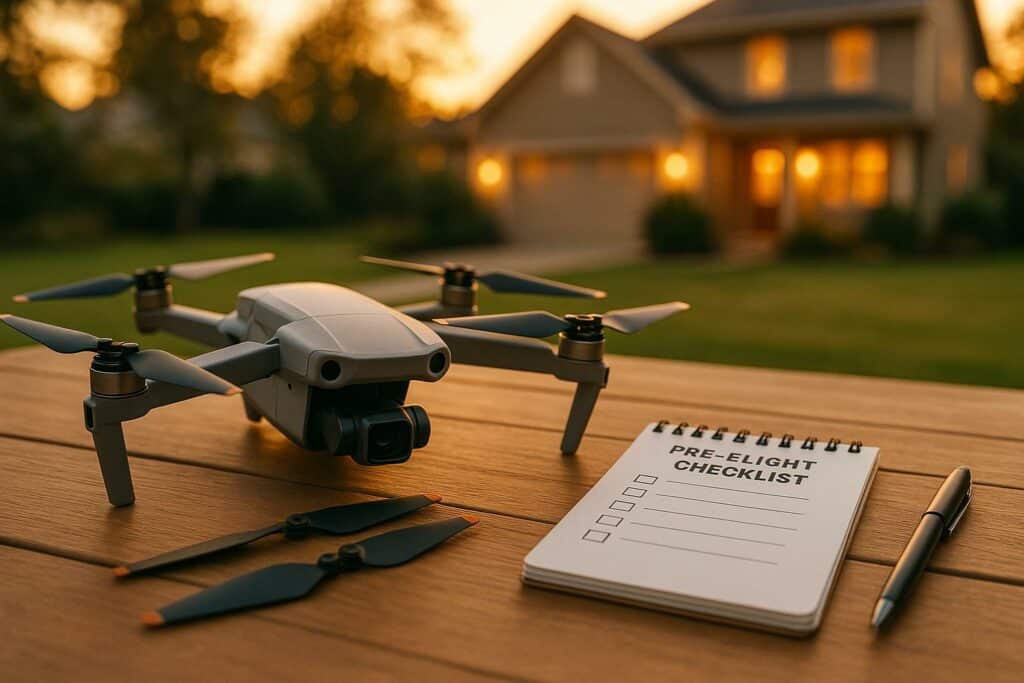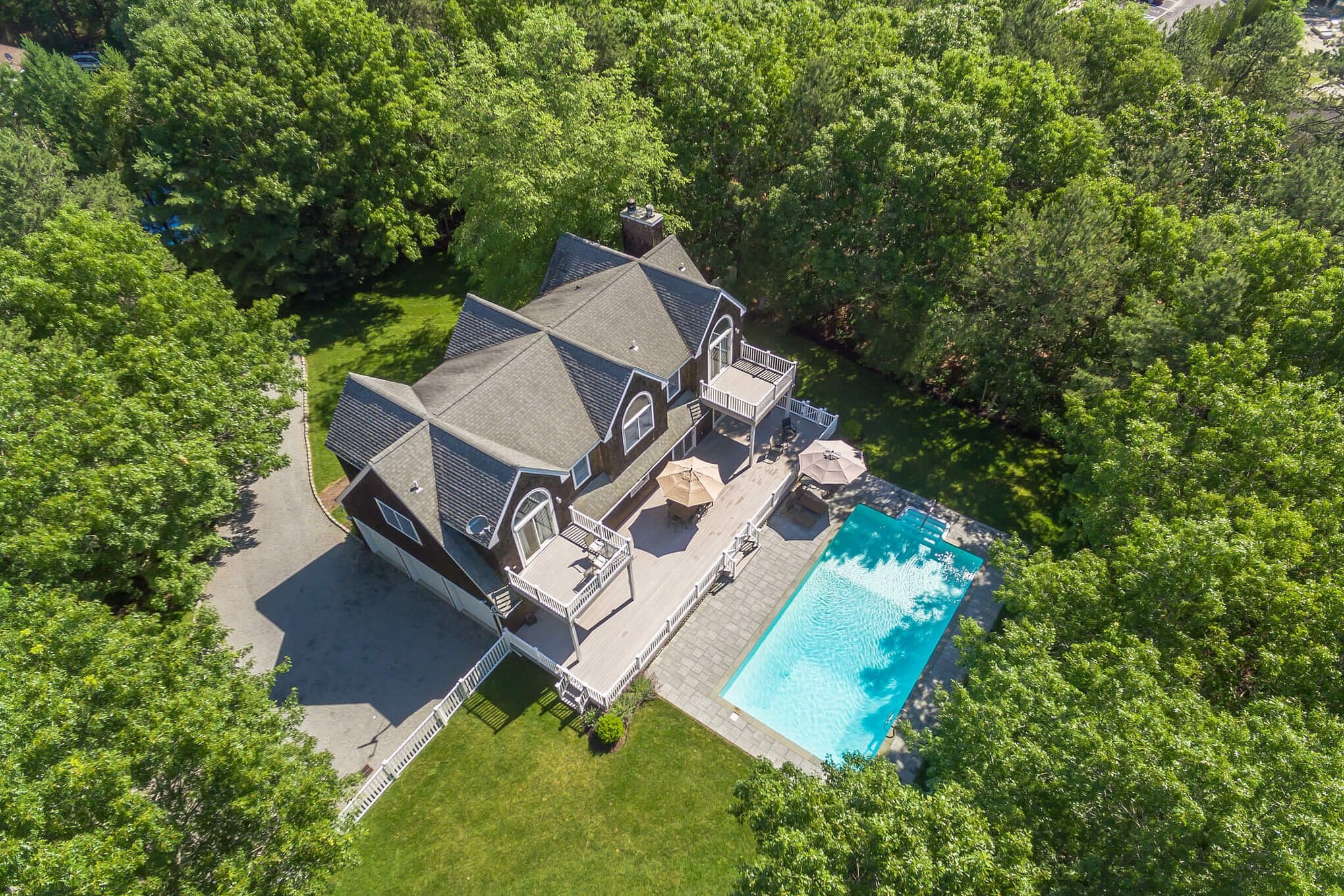Skipping pre-flight drone checks can lead to crashes, lost footage, and damaged equipment. For real estate professionals, these mistakes can harm your reputation and delay projects. Pre-flight inspections are essential for safety, compliance with FAA regulations, and delivering high-quality aerial visuals.
Key Takeaways:
- Battery Checks: Fully charge, inspect for damage, and ensure proper installation.
- Propellers & Frame: Look for cracks, chips, or loose components.
- Firmware & Navigation: Update software, calibrate GPS/compass, and set return-to-home altitude.
- Camera & Sensors: Clean lenses, check obstacle sensors, and prepare SD cards.
- Weather & Airspace: Check wind speeds, temperature, and local flight restrictions.
A systematic pre-flight routine ensures smooth operations, protects your gear, and helps you meet client expectations. Whether you’re working near restricted zones or in challenging conditions, these steps keep your drone reliable and compliant.
BEFORE YOU FLY – 10 Things – PRE FLIGHT Checklist!
Complete Pre-Flight Drone Checklist
A thorough pre-flight checklist is your best safeguard against equipment issues and safety risks. Each step helps ensure smooth operations and top-notch aerial footage, especially for real estate marketing.
Battery Checks
Battery problems are one of the most common causes of drone failures, so managing them properly is critical. Start by fully charging your drone batteries, spare batteries, and the controller before heading out. Many experienced pilots carry at least three batteries to avoid running out of power during a shoot. For longer sessions, a portable power bank can be a lifesaver.
Make sure the batteries are securely installed in the drone, following the guidelines in the user manual. A loose connection could lead to sudden power loss mid-flight. Inspect each battery for physical damage like swelling or leaks, which can indicate wear and pose safety risks. Temperature matters too – keep spare batteries warm in cold weather and shaded in hot conditions to maintain performance.
Once your batteries are good to go, move on to checking the propellers and frame.
Propeller and Frame Inspection
Propellers take a lot of stress during flights, so inspect them closely. Look for cracks, chips, or any damage that could affect stability or image quality. Run your finger along the edges to feel for rough spots that might not be visible. Ensure the propellers are securely attached and seated properly.
Don’t forget to check the drone’s frame. This includes the landing gear, motor mounts, and gimbal assembly. Look for signs of damage or loose screws that could impact the drone’s structural integrity.
When the hardware is in good shape, it’s time to update the software and calibrate navigation tools.
Firmware, GPS, and Compass Setup
Always update your drone’s firmware before flying. These updates often include crucial safety features and performance tweaks. Calibrate the GPS to ensure the drone has a strong satellite connection, which is key for accurate positioning and reliable return-to-home functionality. Compass calibration is equally important, especially if you’re flying in a new area or suspect magnetic interference. Lastly, set your return-to-home altitude high enough to avoid obstacles like trees, power lines, or tall buildings.
Camera and Sensor Preparation
To capture the best aerial shots, clean the camera lens and gimbal components using proper cleaning tools. Dust, smudges, or fingerprints can ruin image quality. Check that obstacle sensors are free of dirt or debris to prevent false readings. Make sure your SD card has enough storage for high-resolution photos and 4K video, and format it as needed. Before takeoff, double-check your camera settings – exposure, resolution, and shooting modes – so you’re ready to capture the perfect shot.
Weather and Airspace Conditions
Before flying, review the weather forecast using a reliable app. High winds – anything over 25 mph – can make flying unsafe and produce shaky footage. Be mindful of temperature changes that might affect battery life or cause condensation on your equipment. Stay prepared for rapid environmental shifts.
Additionally, check local airspace restrictions through trusted apps or the FAA’s resources. Look for any NOTAMs (Notice to Airmen) that might indicate temporary no-fly zones. Survey the area for obstacles like power lines, cell towers, or tall buildings that could interfere with your flight plan. Taking these precautions ensures a safer and more efficient operation.
Common Drone Problems and Solutions
Unexpected issues can disrupt drone performance during a shoot, especially in real estate aerial photography. Knowing how to identify and address these problems can protect your equipment and ensure safe, efficient operations. Let’s break down some common challenges and practical solutions to keep your drone flying smoothly.
Battery Problems
Battery issues are a frequent concern during drone operations. One common problem is voltage sag, where the battery voltage drops under load. If your drone struggles to maintain altitude or feels sluggish, voltage sag might be the cause. Cold weather makes this worse, so it’s a good idea to warm your batteries to about 68°F (20°C) before flying. Keep spare batteries nearby and warm when shooting in winter.
Another issue to watch for is capacity fade, which reduces flight time significantly. This often happens due to improper storage or deep discharging of the battery. If you notice shorter flights, it might be time to replace the battery.
To maintain battery health:
- Ensure each LiPo cell has an internal resistance below 10 mΩ.
- Store batteries at their recommended voltage of 3.8–3.85 V per cell when not in use.
- Keep stored batteries in a temperature range of 59–77°F (15–25°C).
Short circuits are another risk. Inspect battery connectors regularly for wear, bent pins, or corrosion. Use protective caps on terminals when batteries are not in use. If you suspect a short circuit, avoid direct handling – place the battery in a fireproof LiPo bag and follow local hazardous waste disposal guidelines for safe handling.
Propeller Wear and Attachment Problems
Propeller issues can creep up over time and aren’t always obvious during a quick inspection. Stress cracks, even small ones, can lead to mid-air failure. To catch these early, run your finger along the propeller edges to feel for rough spots or tiny chips that might not be visible.
Loose propeller attachments are another concern, especially after hard landings or during transport. Always check that propellers are securely fastened according to your drone’s manual. Hand-tightening is usually enough – just avoid over-tightening to prevent thread damage. If you notice any bends in the propellers, replace them immediately, as they can cause vibrations and affect image stability. Keeping spare propellers on hand is a smart move for any shoot.
Firmware and Navigation Errors
Once hardware issues are addressed, don’t overlook software and navigation challenges. Outdated firmware can lead to navigation glitches or reduced flight stability. Make it a habit to check for and install firmware updates before important shoots.
GPS problems, like weak satellite connections or “GPS not ready” warnings, are common in areas with interference from tall buildings or electronic equipment. Wait until you have at least 8–10 satellite connections before taking off. If GPS readings seem inconsistent, recalibrate your unit following the manufacturer’s instructions.
Compass calibration errors can also arise, particularly when moving between areas with different magnetic environments. Urban settings with plenty of metal structures can disrupt your drone’s compass. If calibration issues pop up, recalibrate the compass using the app’s guidance.
Lastly, double-check your return-to-home settings. Set the return-to-home altitude at least 50 feet higher than the tallest obstacle in your flight area. This precaution is especially important in locations with tall trees or power lines to avoid accidents during automatic returns.
sbb-itb-82c5f45
Adding Pre-Flight Checks to Real Estate Workflows
Thorough pre-flight inspections are the backbone of a reliable drone operation, ensuring both safety and consistent results. When you’re capturing aerial footage for real estate listings, there’s no room for errors – whether it’s equipment malfunctions or poor image quality. By incorporating a structured pre-flight routine into your workflow, you can uphold professional standards and meet client expectations with confidence.
Creating Standard Pre-Flight Procedures
To ensure every flight meets high-quality standards, it’s essential to standardize your pre-flight procedures. Start by creating a written checklist that’s easy to access and tailored to your drone model. This checklist should cover key aspects like battery voltage, propeller security, GPS signal strength, camera settings, and weather conditions. Be specific about acceptable ranges for each parameter to avoid guesswork.
Documenting these checks is equally important. Log details such as battery voltage, GPS lock time, and environmental conditions like wind speed or temperature. Over time, this data can help you spot patterns – for example, if batteries consistently lose voltage in colder weather, you’ll know to adjust your preparation accordingly.
Allocate adequate time for each step of the pre-flight process. While a thorough inspection typically takes about 10–15 minutes, additional time may be needed for tasks like GPS calibration in new locations or compass recalibration in areas with magnetic interference. Building these time buffers into your schedule ensures you’re not rushing critical safety checks, even on tight deadlines.
Supporting Professional Services with Reliable Drone Operations
For professional real estate photography platforms, consistent and high-quality aerial imagery is a must to maintain their reputation and meet client demands. Take HomeJab as an example: their success relies on rigorous pre-flight protocols that ensure dependable aerial footage for property marketing. By following these protocols, photographers can confidently deliver aerial shots alongside HDR photos, video tours, and 3D virtual tours without worrying about equipment failures disrupting the shoot.
A smooth pre-flight process also plays a key role in meeting tight turnaround times, such as 24-hour delivery promises. Skipping pre-flight checks can lead to reshoots, throwing off schedules and increasing costs – not to mention the ripple effect on subsequent bookings.
Consistency is another critical factor. Photographers working across diverse locations – like coastal properties with salty air or urban areas with electromagnetic interference – face varying environmental challenges. A robust pre-flight routine helps them adapt to these conditions while maintaining the same quality standards across all shoots.
Clear communication is equally important. If pre-flight checks uncover equipment issues that could impact the shoot, notifying the platform and client immediately allows for schedule adjustments or alternative solutions. This proactive approach not only builds trust but also reinforces your professionalism.
Post-Flight Maintenance Steps
After completing a flight, proper maintenance is essential to ensure your equipment stays reliable for future use. Post-flight care directly affects the efficiency of your next pre-flight checks and extends the lifespan of your gear.
Start by inspecting propellers for damage. Even minor nicks or stress marks can turn into serious issues over time. Addressing these early prevents unexpected failures during future flights.
Battery care is another critical step. Let batteries cool to room temperature before recharging, especially after intensive flights or operation in hot conditions. Check the battery terminals for debris or corrosion, and clean them gently with a dry cloth if needed. Keeping a maintenance log to track flight times and battery performance can help you monitor capacity degradation over time.
Pay close attention to your drone’s camera and gimbal. Real estate shoots often involve flying in challenging environments, such as construction sites or coastal areas with salt spray. Use lens cloths for cleaning camera elements and compressed air for hard-to-reach spots. Make sure the gimbal is free of debris to maintain smooth stabilization.
When not in use, store your equipment in controlled environments. Temperature fluctuations and humidity can harm electronic components and batteries. If you’re shooting multiple properties in a day, keep spare batteries at moderate temperatures and shield your drone from direct sunlight during transport.
Finally, update your pre-flight checklist based on what you observe during post-flight maintenance. For example, if certain propellers tend to loosen more frequently or specific battery cells degrade faster, adjust your pre-flight routine to address these issues proactively. This ongoing refinement ensures your procedures evolve alongside your equipment’s needs, keeping your operations efficient and reliable.
Conclusion: Improve Your Real Estate Listings with Reliable Drone Operations
Taking the time for pre-flight checks is essential for safe and efficient drone use. Skipping these steps can lead to mid-air malfunctions, damaged gear, delayed shoots, and even a tarnished reputation.
Spending just 10–15 minutes on thorough checks can make a big difference in reliability and client confidence. Professional platforms like HomeJab rely on photographers who consistently provide high-quality aerial photography along with HDR photos, video tours, and 3D virtual tours. This consistency is especially critical when deadlines are tight, leaving no room for equipment failures or reshoots.
As you gain experience, keep refining your pre-flight routine. Tailor your checklist to adapt to your growing expertise and the demands of your equipment. Logging key data can help you identify and avoid potential issues down the line. Whether you’re capturing coastal properties exposed to salt air or urban listings with potential electromagnetic interference, a solid pre-flight process ensures dependable results in any setting.
Staying compliant with FAA regulations is non-negotiable. Regular checks not only meet safety requirements but also protect your business and enhance your professional credibility. Paired with proper post-flight maintenance, these practices can extend your equipment’s lifespan and help you avoid costly repairs.
FAQs
Why are pre-flight checks essential for drone photography in real estate?
Performing pre-flight checks is a must for safe and smooth drone operation during real estate photography shoots. These checks ensure your drone’s battery is fully charged, the propellers are in top shape, and the GPS is calibrated correctly. Skipping this step? That could lead to mid-air malfunctions, accidents, or subpar footage.
Taking just a few minutes to inspect your gear can save you from unexpected interruptions, keep everyone and everything safe, and guarantee your photos and videos meet professional standards. It’s a straightforward but essential step to create the high-quality visuals that real estate professionals depend on to highlight properties.
What are the warning signs of drone battery problems, and how can you prevent mid-air failures?
Drone batteries can face several challenges, such as swelling, overheating, reduced flight times, visible damage, or uneven power output. If left unchecked, these issues can lead to mid-air failures, posing serious risks.
To keep your drone running smoothly, always inspect the batteries before flying. If you notice swelling, overheating, or any physical damage, stop using that battery immediately. Pay attention to high-temperature or overcurrent alerts and avoid pushing your drone beyond its limits. Routine maintenance, proper charging practices, and replacing aging batteries on time are key steps to ensure safe and dependable drone performance.
What steps should real estate professionals take to comply with FAA rules when using drones?
Real estate professionals using drones for commercial purposes must comply with FAA regulations to ensure legal and safe operations. To start, you’ll need to obtain a Remote Pilot Certificate from the FAA, which authorizes you to fly drones commercially. Also, don’t forget to register any drone that weighs more than 0.55 pounds with the FAA.
When flying, stick to important FAA guidelines: keep your drone under 400 feet above ground level, maintain a clear visual line of sight at all times, and avoid flying over people unless you’ve secured the necessary waivers. Additionally, ensure your drone broadcasts the required remote identification information. Following these rules helps you operate drones responsibly while staying compliant with FAA requirements.














